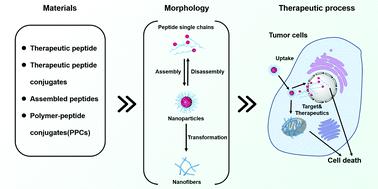当前位置:
X-MOL 学术
›
Biomater. Sci.
›
论文详情
Our official English website, www.x-mol.net, welcomes your feedback! (Note: you will need to create a separate account there.)
Recent progress of therapeutic peptide based nanomaterials: from synthesis and self-assembly to cancer treatment
Biomaterials Science ( IF 6.6 ) Pub Date : 2020-09-10 , DOI: 10.1039/d0bm01358g Ruo-Chen Guo 1, 2, 3, 4, 5 , Xue-Hao Zhang 5, 6, 7, 8, 9 , Lei Ji 5, 6, 7, 8, 9 , Zi-Jin Wei 5, 6, 7, 8, 9 , Zhong-Yu Duan 1, 2, 3, 4 , Zeng-Ying Qiao 5, 6, 7, 8, 9 , Hao Wang 5, 6, 7, 8, 9
Biomaterials Science ( IF 6.6 ) Pub Date : 2020-09-10 , DOI: 10.1039/d0bm01358g Ruo-Chen Guo 1, 2, 3, 4, 5 , Xue-Hao Zhang 5, 6, 7, 8, 9 , Lei Ji 5, 6, 7, 8, 9 , Zi-Jin Wei 5, 6, 7, 8, 9 , Zhong-Yu Duan 1, 2, 3, 4 , Zeng-Ying Qiao 5, 6, 7, 8, 9 , Hao Wang 5, 6, 7, 8, 9
Affiliation

|
Peptides have shown great potential in cancer treatment due to their good biocompatibility and low toxicity. However, the bioavailability and adverse immune response of peptides limit their further translation from bench to bedside. Over the past few decades, various peptide-based nanomaterials have been developed for drug delivery and cancer treatment. Compared with therapeutic peptides alone, self-assembled peptide nanomaterials have obvious advantages, such as improved stability and biodistribution for high-performance cancer therapy. In this review, we have described the synthesis, self-assembly and the anti-cancer application of therapeutic peptides and their conjugates, particularly polymer–peptide conjugates (PPCs).
中文翻译:

治疗性肽基纳米材料的最新进展:从合成,自组装到癌症治疗
肽由于其良好的生物相容性和低毒性而在癌症治疗中显示出巨大潜力。但是,肽的生物利用度和不良免疫反应限制了它们从实验台到床边的进一步翻译。在过去的几十年中,已开发出各种基于肽的纳米材料用于药物递送和癌症治疗。与单独的治疗性肽相比,自组装肽纳米材料具有明显的优势,例如用于高性能癌症治疗的稳定性和生物分布得到改善。在这篇综述中,我们描述了治疗性肽及其缀合物,特别是聚合物-肽缀合物(PPC)的合成,自组装和抗癌应用。
更新日期:2020-11-03
中文翻译:

治疗性肽基纳米材料的最新进展:从合成,自组装到癌症治疗
肽由于其良好的生物相容性和低毒性而在癌症治疗中显示出巨大潜力。但是,肽的生物利用度和不良免疫反应限制了它们从实验台到床边的进一步翻译。在过去的几十年中,已开发出各种基于肽的纳米材料用于药物递送和癌症治疗。与单独的治疗性肽相比,自组装肽纳米材料具有明显的优势,例如用于高性能癌症治疗的稳定性和生物分布得到改善。在这篇综述中,我们描述了治疗性肽及其缀合物,特别是聚合物-肽缀合物(PPC)的合成,自组装和抗癌应用。



























 京公网安备 11010802027423号
京公网安备 11010802027423号